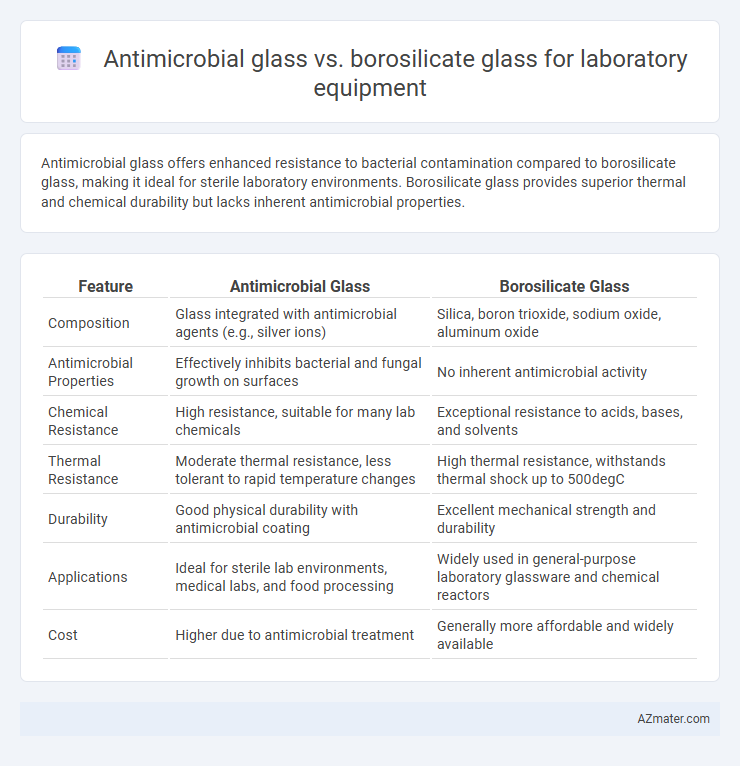Antimicrobial glass offers enhanced resistance to bacterial contamination compared to borosilicate glass, making it ideal for sterile laboratory environments. Borosilicate glass provides superior thermal and chemical durability but lacks inherent antimicrobial properties.
Table of Comparison
| Feature | Antimicrobial Glass | Borosilicate Glass |
|---|---|---|
| Composition | Glass integrated with antimicrobial agents (e.g., silver ions) | Silica, boron trioxide, sodium oxide, aluminum oxide |
| Antimicrobial Properties | Effectively inhibits bacterial and fungal growth on surfaces | No inherent antimicrobial activity |
| Chemical Resistance | High resistance, suitable for many lab chemicals | Exceptional resistance to acids, bases, and solvents |
| Thermal Resistance | Moderate thermal resistance, less tolerant to rapid temperature changes | High thermal resistance, withstands thermal shock up to 500degC |
| Durability | Good physical durability with antimicrobial coating | Excellent mechanical strength and durability |
| Applications | Ideal for sterile lab environments, medical labs, and food processing | Widely used in general-purpose laboratory glassware and chemical reactors |
| Cost | Higher due to antimicrobial treatment | Generally more affordable and widely available |
Introduction to Laboratory Glassware: Antimicrobial vs Borosilicate
Antimicrobial glass incorporates surface treatments or embedded agents that inhibit microbial growth, enhancing sterility and reducing contamination risks in laboratory settings. Borosilicate glass, valued for its exceptional thermal resistance, chemical durability, and mechanical strength, remains a standard choice for laboratory glassware where heat and chemical exposure are prevalent. Comparing these materials highlights the trade-off between antimicrobial properties for hygiene and the robust thermal and chemical performance essential for rigorous laboratory applications.
Key Material Properties: Antimicrobial Glass Explained
Antimicrobial glass incorporates active ions like silver or copper that inhibit microbial growth on its surface, providing enhanced hygiene and reducing contamination risk in laboratory environments. Borosilicate glass is renowned for its thermal resistance, chemical durability, and low thermal expansion, making it the standard choice for laboratory apparatus requiring heat resistance and chemical stability. While borosilicate glass excels in mechanical and thermal properties, antimicrobial glass offers an added layer of bio-protection, ideal for settings where contamination control is critical.
Borosilicate Glass: Traditional Staple in Laboratories
Borosilicate glass remains the traditional staple in laboratories due to its exceptional thermal resistance, chemical durability, and mechanical strength, making it ideal for precise experimental conditions. Its high resistance to thermal shock allows repeated heating and cooling without cracking, which is essential for consistent laboratory performance. Although antimicrobial glass offers surface protection against microbial contamination, borosilicate glass's proven reliability and broad chemical compatibility continue to secure its dominant role in scientific applications.
Chemical Resistance: How Each Glass Type Performs
Antimicrobial glass exhibits enhanced resistance to microbial contamination but typically has similar chemical resistance properties to standard soda-lime glass, which is less resistant to strong acids and alkalis compared to borosilicate glass. Borosilicate glass is highly valued in laboratory settings for its superior chemical resistance, with excellent durability against corrosive chemicals such as sulfuric acid, sodium hydroxide, and organic solvents. This makes borosilicate glass the preferred choice for lab equipment requiring repeated exposure to harsh chemicals, ensuring longevity and minimal leaching during experiments.
Antimicrobial Protection: Mechanisms and Benefits
Antimicrobial glass incorporates biocidal agents such as silver or copper ions within its matrix, disrupting microbial cell membranes and inhibiting biofilm formation, thereby reducing the risk of contamination in laboratory settings. In contrast, borosilicate glass, while chemically resistant and thermally stable, lacks intrinsic antimicrobial properties and may require external disinfection protocols to ensure sterility. The integration of antimicrobial protection in glassware enhances laboratory safety by minimizing microbial growth on surfaces, extending equipment longevity, and decreasing the frequency of sterilization cycles.
Durability and Temperature Tolerance Comparison
Antimicrobial glass offers enhanced resistance to microbial growth while maintaining high durability, making it ideal for sterile laboratory environments, but its temperature tolerance typically maxes out around 150degC. Borosilicate glass is renowned for its superior thermal shock resistance and can withstand temperatures up to 500degC, making it highly durable under extreme heat conditions. For laboratory equipment requiring high-temperature applications, borosilicate glass provides better performance, whereas antimicrobial glass excels in maintaining cleanliness and preventing contamination.
Safety Considerations: Contamination and Breakage
Antimicrobial glass for laboratory equipment reduces contamination risks by inhibiting microbial growth on surfaces, enhancing laboratory hygiene and safety. Borosilicate glass, known for its thermal and chemical resistance, offers superior breakage resistance but lacks inherent antimicrobial properties. Prioritizing antimicrobial glass improves contamination control, while borosilicate glass provides durability against physical and thermal stresses in laboratory environments.
Cost Analysis: Investment vs Long-term Value
Antimicrobial glass typically involves higher initial investment costs due to specialized coatings or embedded agents that reduce microbial growth, enhancing laboratory safety. Borosilicate glass, known for its chemical resistance and thermal durability, presents lower upfront costs but may require more frequent replacement or cleaning to maintain sterility. Long-term value analysis favors antimicrobial glass in high-contamination-risk environments by reducing maintenance expenses and downtime, whereas borosilicate glass remains cost-effective for general-purpose laboratory usage.
Application Suitability in Laboratory Settings
Antimicrobial glass offers enhanced protection against microbial contamination, making it ideal for applications requiring stringent sterility, such as cell cultures and microbiological assays. Borosilicate glass excels in thermal resistance and chemical durability, suitable for high-temperature processes and reactions involving aggressive chemicals. Selecting antimicrobial glass improves cleanliness and reduces contamination risk, while borosilicate glass ensures reliability in heat-intensive experiments and chemical handling.
Future Trends and Innovations in Laboratory Glassware
Antimicrobial glass integrates silver ion technology to inhibit microbial growth, enhancing sterility in laboratory environments, while borosilicate glass remains favored for its exceptional thermal resistance and chemical durability. Future trends emphasize the development of hybrid glass materials combining antimicrobial properties with borosilicate's robustness to improve safety and longevity in labware. Innovations include nano-coatings and smart glass technologies that enable real-time contamination monitoring and self-cleaning functions, driving next-generation laboratory glassware performance.

Infographic: Antimicrobial glass vs Borosilicate glass for Laboratory equipment
 azmater.com
azmater.com